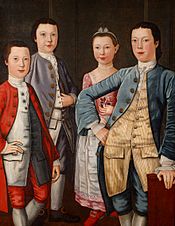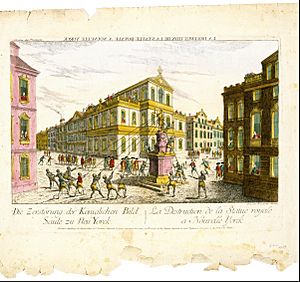History of New York City (1665–1783) facts for kids
The history of New York City (1665–1783) covers the time when England took control of the Dutch colony of New Amsterdam and renamed it. As the city of New York grew, some people wanted independence, while others remained loyal to the British. New York City was a key location for major battles during the early American Revolutionary War. After these battles, the British occupied the city until the war ended in 1783. It was the last port the British left in America.
Early English Rule
The English renamed the colony the Province of New York, honoring the king's brother, James, Duke of York. On June 12, 1665, Thomas Willett became the first Mayor of New York. The city expanded northward and became the largest and most important city in the Province of New York. It was the third-largest city in the British Empire, after London and Philadelphia.
The Dutch briefly took back the colony in 1673. However, they traded it back to the English in 1674 as part of the Treaty of Westminster, which ended the Third Anglo-Dutch War.
Leisler's Rebellion was an uprising from 1689 to 1691. During this time, militia captain Jacob Leisler took control of lower New York. This happened during England's "Glorious Revolution" and showed how colonists felt about King James II. In the 1680s, King James II had created royal colonies like New York, New Jersey, and the Dominion of New England, making New York City their capital. English troops sent by James's successor, William III, restored royal authority in 1691.
New York was a diverse city from the start, built mainly as a trading post. People from many different backgrounds lived there. A visitor during the revolutionary period noted that the people were "brisk and lively." He also saw many enslaved people on the streets. There were many marriages between people from different ethnic groups. For example, many English men in the late 1600s married women who were not English. By the 1730s, most Dutch men and women still married within their own groups, but there were also many children of mixed European heritage.
Freedom of worship was a core part of the city. In 1735, the trial of John Peter Zenger, editor of the New-York Weekly Journal, was very important. He was accused of libel (printing false information), but his trial helped establish the idea of freedom of the press in the British colonies. Sephardi Jews who were forced to leave Dutch Brazil were welcomed in New York. The governor realized they could help the city and gave them special permissions.
In 1741, there was a major event known as the New York Slave Insurrection of 1741. Many enslaved people were accused of setting fires and planning a rebellion. This led to a time of great fear and severe consequences for many enslaved people.
Road to Revolution
New York City was the main base for British operations during the French and Indian War (1754–1763). This war brought the colonies together for the first time to defend themselves. It also removed the main military threat that the colonists had relied on Britain to protect them from.
Two years after the war ended, in 1765, the British Parliament passed the Stamp Act. This law was meant to help pay for defending the colonies. In response, delegates from nine colonies met at what is now Federal Hall in Manhattan to protest the act. This meeting was called the Stamp Act Congress.
The Sons of Liberty was a secret group of patriots who sometimes used violence. They formed groups in New York and other cities and worried royal officials. From 1766, after the Stamp Act was repealed, until the rebels took control in 1775, the "Sons" often clashed with British authorities over setting up liberty poles in public places. These poles, often topped with a red cap, were places where people gathered to protest the colonial government. New York City was a main center of organized political resistance, first with the Committee of Sixty and later the New York Provincial Congress.
After the Declaration of Independence was first read, the statue of King George III in Bowling Green was pulled down. The metal from the statue was melted to make musket balls. However, New York City also had many people who supported the King. It likely had more Loyalists than most other places in the colonies, though they were probably still not a majority.
In 1776, General George Washington and his troops moved to defend Manhattan and New York Harbor. Before about a third of the city's population fled, the Continental Army found a wealthy city, busy with trade, shipbuilding, and shipping. The city was built for sea travel and trade. Manhattan's only connection to the mainland was the narrow King's Bridge over the Harlem River, about 11 miles north of the city. People also used ferries across the North (Hudson's) River. Most of the 20,000 people lived in a small area near the East River wharves and New York Harbor.
The city's traders, stockbrokers, and sailors brought great wealth. Some American soldiers noted the "magnificent" horse carriages and fine furniture. They also observed that some New Yorkers were very proud and used bad language.
American Revolutionary War
General Washington correctly guessed that after their defeat at the Siege of Boston, the British would try to divide the colonies by capturing New York City's important port and waterways. So, in the summer of 1776, he began to fortify the city and took personal command of the Continental Army there.
Five battles, part of the New York Campaign, were fought around the city in late 1776. The first was the Battle of Long Island in Brooklyn on August 27. This was the largest battle of the entire war.
A quarter of the city's buildings were destroyed in the Great Fire on September 21. This happened a few days after the British Landing at Kip's Bay and the Battle of Harlem Heights. The Battle of Harlem Heights was the only American victory in this part of the campaign, and it greatly helped morale. After the suspicious fire, British authorities questioned many people, including Nathan Hale, who was executed a day later for spying. The British took full control of Manhattan when Fort Washington fell and Fort Lee (in New Jersey) was evacuated on November 16, 1776. The British held the city until 1783. Major General James Robertson, who was in charge of the city, took houses from rebels who had left and gave them to British officers.
Because the British quickly succeeded, they occupied the city. Any remaining Patriots left, and many Loyalist refugees from other colonies moved in. This made the city strongly Loyalist for the rest of the British occupation. New York became the main British political and military center for the rest of the war. For this reason, the "British Headquarters Map" was drawn in 1782, which is the best map of Manhattan Island's natural state at that time.
The city's role as the British center made it a key target for Washington's intelligence network. American prisoners were kept in very difficult conditions on rotting British prison ships in nearby Wallabout Bay on the East River, between New York and Brooklyn, for much of the war. The goal was to make conditions so bad that soldiers would choose to join the British navy instead. Many more American soldiers and sailors died on these ships from illness and lack of care than in all the battles of the Revolution combined.
The anniversary of Evacuation Day, when the last British troops and many Loyalist supporters left in November 1783, was celebrated in New York for a long time.
After the War
When the British left in 1783, they took many Loyalists with them, including important business people, lawyers, bankers, and religious leaders. The Anglican Church had been very powerful during the colonial period. It lost much of its influence when many of its members left. It also lost funding from the British Society for the Propagation of the Gospel and was later separated from the state in 1784. This meant it lost control of King's College (now Columbia University). The city became more democratic and offered more opportunities for ambitious people from middle-class and poorer backgrounds.
|
See also
 In Spanish: Historia de Nueva York (1665-1783) para niños
In Spanish: Historia de Nueva York (1665-1783) para niños






